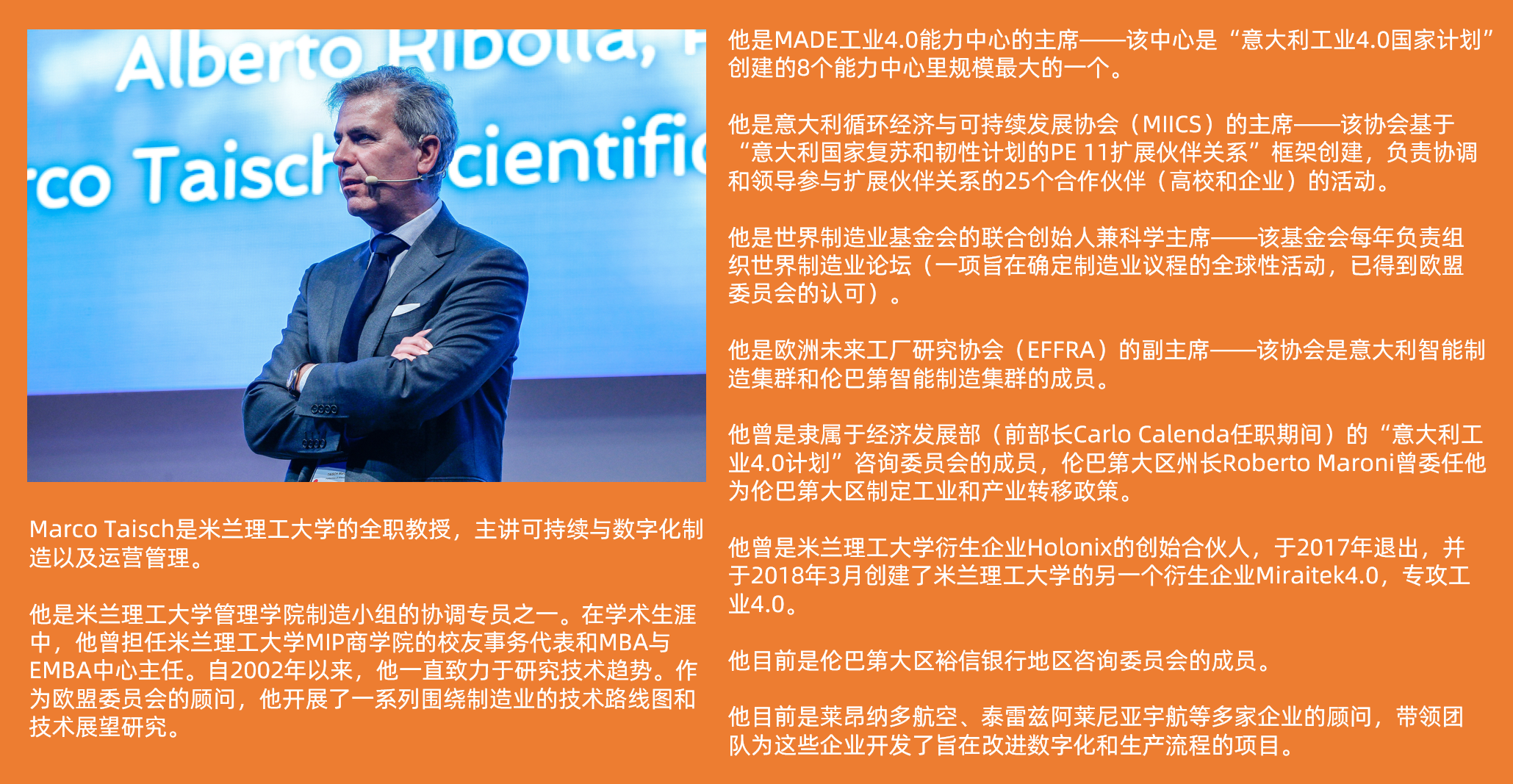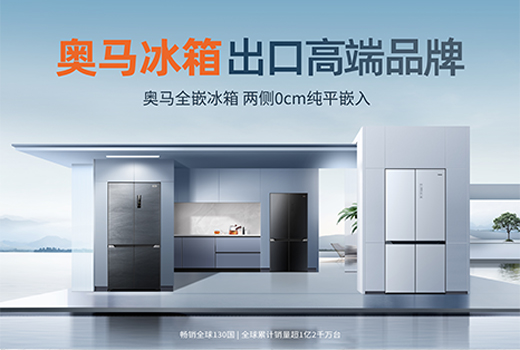传统上,制造需协调两个明显对立的需求:大规模生产和产品个性化。奥马专注冰箱研发与制造,主要为海外合作伙伴生产冰箱,因此除上述两个需求外,还要考虑一个额外因素,即自己的产品将贴上第三方的品牌进行销售。这些产品必须保有一定程度的品牌视觉识别,以便从商店琳琅满目的白色家电中脱颖而出。米兰理工大学的研究员兼教授Marco Taisch从学术角度为我们提供了这方面的宝贵见解。

How do we efficiently manage the needs of very large-scale production with the need to personalise the products?
我们如何有效地平衡大规模生产和产品个性化?
The reconciliation of these two factors actually began in 1908 with the Ford T, and the effort to bring more and more customisation to products, while maintaining high production volumes. Then after the second World War mass customisation exploded. On the one hand, people’s income increased, and the consumer was no longer content to have just any car of any type, any shape, as long as it was black! While on the other hand, that famous marketing slogan in fact disguised the production requirement to keep costs to a minimum, with a higher sale price based on customisation balanced with extreme production standardisation.1908年,福特T型车问世。它在保持高产量的同时,努力为产品注入个性,这是大规模生产和产品个性化的首次碰撞。第二次世界大战后,大规模定制开始崛起。随着收入的增加,“无论类型、无论款式,只要是黑色就行”的汽车无法再令消费者满意。因为在这句著名营销口号的背后,是企业将成本控制在最低的生产策略,但此时消费者想要的,是在昂贵定制化和极端标准化之间达成平衡的产品。
Consumers today aren’t only sensitive towards price, but also to a hyper personalisation
如今的消费者不仅对价格敏感,而且对超个性化的要求也很高。
Today, there are various factors to take into consideration. First, consumers today aren’t only sensitive towards price, but also to a hyper personalisation. What do I mean by that? It means that a product has to meet the needs of an individual, rather than a group or segment of consumers. So how do we manage the needs of cost-efficient standardised production and such specific consumer needs?
当前,企业需要考虑众多因素。首先,如今的消费者不仅对价格敏感,而且对“超个性化”(hyper personalisation)的要求也很高。这意味着什么?意味着产品必须满足个人的需求,而不仅仅是群体或细分客群的需求。标准化生产具有成本效益,但消费者的需求各不相同,如何在二者之间取得平衡呢?
Well, unlike in the past, we have moved on from the matter of volumes. Whether a factory produces 100 pieces or 1000 pieces, thanks to the advances in production systems, there is a high level of flexibility. Basically, manufacturing technology and digital technology are now the same, allowing us extremely high levels of customisation and personalisation. So in fact the need to reconcile these two factors is hardly a problem anymore. The problem existed when there was inflexibility in the production system, when passing from one model or variation to another meant you had to intervene with tools or with factory configurations that were inevitably physical or mechanical. For example, you’d have to change the machine press, or manually change the machine settings. Today, all these configurations are managed via software, and so take zero time.
与过去不同的是,我们如今已摆脱了批量生产的束缚。得益于生产系统的进步,如今工厂可自由决定生产数量,无论是100件还是1000件。制造技术已基本与数字技术一样,可满足极高水平的定制化和个性化需求。因此,大规模生产与产品个性化已不再难以调和。过去,生产系统灵活性不足,在不同型号、数量间转换很困难,必须从物理或机械角度采用工具干预或更改工厂配置。例如,更换压力机或手动更改机器设置。如今,所有配置都通过软件管理,无需耗费人工。
Another factor is the ability of the very talented designers who can generate personalisation with perhaps a little sleight of hand magic for the consumer. What I’m talking about is the concept of perceived personalisation. The hidden part of the product is highly standardised, but if I go on the website of a white goods manufacturer, I see 45 different models of refrigerator. I’m in the process of doing up my house, so am currently immersed in this. I know that there are maybe a limited number of basic configurations, but last-minute software interventions provide a host of apparently different models.
此外,设计师也功不可没。他们富有创造力,善于为消费者带来个性化产品,有时甚至能令消费者眼前一亮。这里是指感知维度的个性化。虽然产品的“内部”高度标准化,但浏览某白色家电企业的网站时,却能看到45种不同型号的冰箱。我目前正在装修自己的房子,所以对这点感触颇深。虽然产品的基本配置差异不大,但最终通过软件定制,却能得到大量有明显差异的产品。
And how much has this standardisation of products, been influenced by the automotive industry, who use the concept of the standardised ‘platform’?
产品标准化受汽车行业的标准化“平台”概念影响有多深?
Very much so. The automotive industry calls it a ‘platform’, in other industries they use other terms. In kitchen design for example, it’s called module standardisation. If you look at the catalogues of the big-name kitchen specialists you’ll see reference to 60 cm, 45 cm, 30 cm modules. And very interestingly, there’s a huge work of standardisation in kitchen provision that in many cases has emerged in an unplanned way. While in the car market each individual manufacturer has said, “I’ll create my own platform that will help me to make the most vehicles in my range”, in the kitchen market, standardisation has emerged from the bottom up. With kitchen furniture modules of 60cm, 45cm, 30cm, you have to install an appliance of those dimensions, and it’s not as if the white goods manufacturers and the kitchen manufacturers got together and agreed on this, it emerged by itself. So ultimately the concept is to modularise the product as much as possible and play around with all the different possibilities.很深。汽车行业称之为“平台”,而其他行业则各有自己的术语。例如,厨房设计行业称之为模块标准化。翻看知名厨房品牌的商品目录,可以找到60厘米、45厘米、30厘米的模块。十分有意思的是,厨房中标准化模块的诞生往往未经规划。汽车制造商致力于“建立自己的平台,从而最大化生产效率”;而在厨房领域,标准化是自下而上进行的。由于厨房家具模块分为60厘米、45厘米或30厘米,因而电器必须符合相应尺寸。但这一规则并不是白色家电制造商和厨房制造商共同商定而成,而是约定俗成的。最终,产品标准化的概念演变为尽可能地将产品模块化,并在此基础上尝试不同可能性。
How does the need for hyper personalisation impact manufacturers who operate on a very large scale?
超个性化需求对大规模生产的制造商有何影响?
Chinese producers, like all manufacturers around the globe, are facing a huge change in consumer expectations which in many cases have become more extreme post-Covid. Young people are driving this, but all demographics are affected.中国制造商和全球所有制造商一样,正面临着消费者期望的巨大变化。多种迹象表明,新冠疫情后,消费者的期望变得更加极端。这一变化由年轻消费者驱动,但几乎所有消费者都或多或少被同化。
The first factor as mentioned above is hyper personalisation. This already existed for 10 or 20 years before Covid, but has become more accentuated every year. If you think about young people today and the market for trainers, they absolutely take for granted that they can go on to their favourite brand’s website and customise a pair of shoes. This is not now seen as value added but as a market necessity that goes without saying. You offer a range of products that are extremely customisable or you’re out of business.
正如刚才提到的,超个性化是首要原因。早在新冠疫情爆发前10到20年,超个性化就已经存在,并且这一趋势日益明显。如今,当年轻人想要购买运动鞋时,他们会理所当然地前往喜欢的品牌网站进行定制化选购。定制已不再是产品附加值,而是进入市场的必要条件。可定制性不足的产品终将被市场淘汰。
The second requirement which is much more noticeable now, is very reduced delivery times. When we were in lockdown, the only way to have products at home was via e-commerce. Many people who before lockdown had not used e-commerce now had no choice, and discovered that they could receive practically anything in 24 hours. Once Covid was over, this experience changed their purchase processes.
另一个明显趋势是交付时间大幅缩短。疫情封控期间,网购成为了购物的唯一途经。封控前,许多人从未尝试过网购,但彼时他们别无选择。然而,他们惊讶地发现,网购支持24小时下单,随时随地都可收到商品。疫情结束后,他们的购物习惯随之改变了。
Although they could return now physically to the shops, they continued to buy online. What does this experience say to me as a consumer? It says: “Everything, immediately!” So today, you provide fast delivery times, or you have problems. What China is doing to tackle these requirements is building ways to get closer to the markets they serve, through partnerships and investments.
尽管现在又可以亲自前往商店购物了,但他们仍会继续网购。网购对消费者而言意味着什么?它意味着“随时随地提供你想要的一切”!所以如今,商品交付必须快速,否则消费者就不愿买单。为了满足上述消费趋势,中国正在通过合作和投资的方式,与所服务的市场建立更紧密的联系。
Are there any other factors that are affecting the efficient and fast delivery of goods on a global scale?
是否还有其他因素正影响着全球范围内商品的高效快速交付?
Absolutely. Think about how globalised logistics worked until recently. It was the nervous system of the world, and it worked perfectly. Then came Covid, lockdowns, blocked ports, ships obstructing the Suez Canal, and we discovered that logistics isn’t as reliable as we thought.是的。我们不妨想想前几年的国际物流运作。国际物流就像全世界的神经系统,并且一度运行顺畅。但新冠疫情爆发后,封控、港口封锁、船只堵塞苏伊士运河等一系列事件随之而来,我们发现物流并不像我们想象的那样可靠。
So large manufacturers need to be thinking about how to ensure that global logistics work, avoiding bottlenecks.
因此,大型制造商需要思考如何确保全球物流正常运作,以避免运输中断。
There needs to be a rapid increase in the production and provision of containers, and longer-term investment in the expansion of ports’ capacity.
这就要求迅速扩大集装箱的生产和供应,并借助长期投资增强港口的吞吐能力。
In fact, in the specific case of Homa, I believe they started 20 years ago to invest in and partner with the Chinese ports to guarantee the free flow of their traffic towards the rest of the world
而为了确保货物能够自由地运往世界各地,奥马早在20年前就开始投资中国港口并与其建立战略合作关系。
“Future decisio“ns for companies and manufacturers will have to tap into the behaviour of young people: every choice is based on information gathering before decision-making.”
“企业和制造商的未来决策必须挖掘年轻人的行为习惯:每个决策都基于决策前的信息收集。”
What are the emerging technologies today that can help improve quality and efficiency in production?
如今,哪些新兴技术有助于提高生产品质和效率?
The same ones we’ve been seeing for around the last 10 years, under the umbrella of Industry 4.0. big data, cloud computing, 5G. 5G private networks, for example, are very important. Enabling the flow of large amounts of data via 5G means we can control machines remotely which we’re unable to do with 4G, because currently to control a robot with 4G you need a cable.正是过去10年里工业4.0框架下诞生的一系列技术,大数据、云计算、5G……举例来说,5G专用网络之所以重要,是因为它支持海量数据的传输,使我们得以远程控制机器人。这是4G无法做到的,目前使用4G控制机器人仍需线缆。
Blockchain is used a lot in the world of finance, whereas in factories currently I don’t see it a great deal.
区块链在金融领域应用广泛,但目前在工厂中还不太普及。
As long as the consumer continues to trust the brand as a guarantee of quality, the watertight assurance of blockchain isn’t yet needed in this world.
只要消费者仍认为品牌是品质的保证,那制造业就暂时还无需区块链的保证。
What are the main challenges for domestic refrigerators in the next 10 years and how can we overcome them?
未来10年家用冰箱面临的主要挑战是什么?如何克服这些挑战?
If we’re looking at the next 10 years we have to consider the outlook and expectations of today’s children and teenagers who will grow up over that decade. We’ve already looked at reduced delivery times. Today young people make no distinction between buying a T-shirt or a fridge or a car. They want it tomorrow morning. When I told my 4 years old daughter the disappointing news that our new car would be delivered in 4 months’ time, so we would have to go on holiday in the old one, she said “Daddy, go on Amazon and they’ll send it to you tomorrow morning!” This is the consumer of tomorrow. Buying habits are changing. People don’t plan any more. In the past, we went shopping at the supermarket on Saturday afternoon with a list for everything we needed for the week. We don’t do that now. We know we can go online to our favourite website or our local supermarket who can deliver the stuff in 2 hours. Mid-afternoon we can ask ourselves what we want to eat tonight because we know we can order it and it will be delivered to the office before we go home at 6.00pm. So we hardly plan, because we know everything is available.放眼未来10年,我们必须考虑在这10年中成长起来的少年儿童的愿景和期望。我们刚才已经探讨过缩短交付时间的问题了。无论是购买T恤、冰箱还是汽车,现在的年轻人都一视同仁地希望它明早就能送到。有一天,我对4岁的女儿说有个坏消息,我们的新车要4个月后才能送到,所以我们得开着旧车去度假,她回答我说:“爸爸,上亚马逊吧,他们明天早上就能送过来!”这就是未来的消费者。购买习惯正在改变,人们不再提前计划。过去,我们会在周六下午带着一周所需物品的清单去超市购物。现在,我们不再这么做了。我们知道可以上喜欢的平台或本地超市的线上渠道购物,并且2小时内就能送货上门。因此,只需在下午3点左右思考一下今晚想吃什么,然后去网上下单,就能在6点离开办公室前收到订购的商品了。所以我们不再提前计划,因为想要什么都能随时买到。
A second important point is that youngsters are not just ‘digital natives’ but ‘sustainable natives’. You can sell me an A class refrigerator with low energy usage, but this is no longer enough. You must guarantee that it comes from an A class factory, that it has a low impact on the environment. And young people today have an awareness of the life cycle of the product. You can’t content them by saying this has low consumption because immediately their next question is about recycling and green production. They want guarantees on this.
第二个重要问题是,年轻人既是“数字原住民”,也是“可持续发展原住民”。他们不仅要求冰箱本身符合低能耗的A级标准,而且对冰箱生产厂商也有同样的要求,希望冰箱的制造过程对环境影响很小。年轻人如今已形成产品生命周期意识。低能耗已无法令他们满意,他们接下来关注的重点是循环利用和绿色生产,只有满足这些条件的产品才能让他们买单。
Is the environmental impact of the production phase significantly lower than that of energy consumption and disposal?
生产阶段对环境的影响是否明显小于能源消耗与报废阶段?
Absolutely. In the automotive industry, it’s around 30% on the production side and 70% in usage. In white goods, it’s around 5-10% in production and 90-95% during usage and disposal.是的。在汽车领域,生产阶段的环境影响约占30%,使用阶段占70%。在白色家电领域,生产阶段的环境影响约占5-10%,使用和报废阶段占90-95%。
What about greenwashing, do young people trust companies, brands?
年轻人是否信任企业和品牌喊口号式的可持续态度?
No, they don’t trust them. They have an innate awareness deriving from their digital knowledge. There is of course a dilemma and a challenge here. They do tend to trust information that they find online. But there is a crucial question: is what they find online true, reliable? In this case, possibly blockchain could become the answer, providing a way to reliably navigate this mass of more or less verifiable online information. Future decisions for companies and manufacturers will have to tap into the behaviour of these young people. If you study their behaviour, choices and decisions, everything is based on information gathering before decision- making. They ask themselves, “What shall I do today?”, and then they visit their favourite sites and make a decision based on what they see there.不信任。对于数字化的认知使他们天然地形成了一种意识,即倾向于相信自己从网上搜寻到的信息。这对于企业和品牌而言是个难点。但有一个关键问题:从网上搜寻到的信息是否真实可靠?区块链或许是个办法,因为它有助于提高参差不齐的网络信息的可靠性。企业和制造商的未来决策必须考虑年轻人的行为习惯。仔细研究年轻人的行为、选择和决策后,便会发现一切都基于决策前的信息收集。当他们思考今天该做些什么时,会访问喜欢的网站,并根据网站上的内容做出决定。
So in our case, the subject of monitoring data, information, the factory, energy consumption, is fundamental. Of course they don’t go to China and do an audit of the factory, that’s where businesses will be created that monitor and certify the energy use of the refrigerator or the energy consumption in the factory.
所以对奥马而言,监测数据、信息、工厂、能耗是赢得年轻人信任的关键。当然,他们不会前往中国,实地去工厂考察。但正因如此,企业才更需要建立监测体系,向消费者证明自己的冰箱和工厂符合低能耗标准。
版权归广东奥马冰箱有限公司所有,转载请注明出处。





























